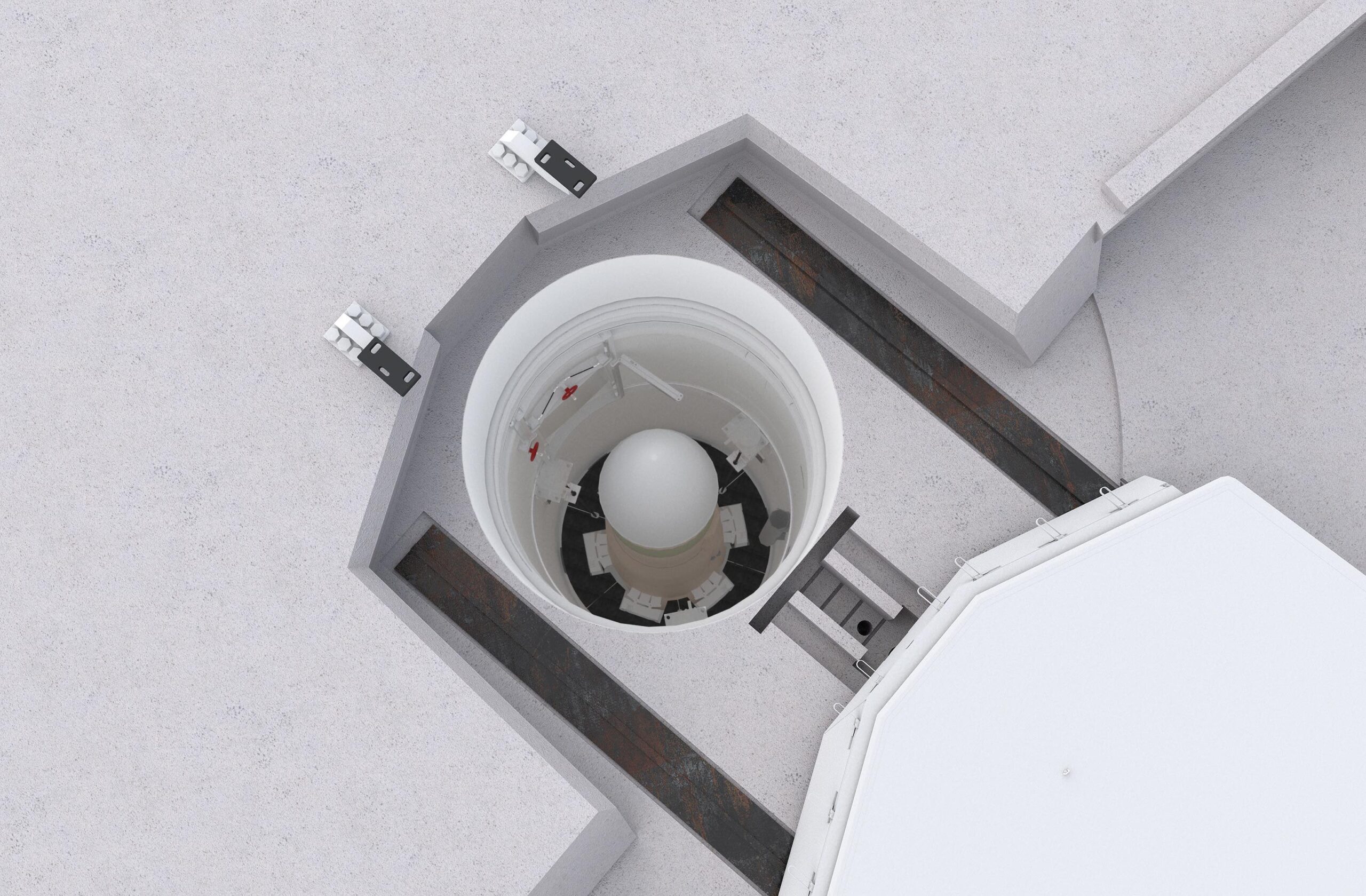
US Air Force artist’s rendering of the Sentinel in flight. (Credit: US Air Force)
Modernization of America’s strategic deterrence capability is continuing apace for two legs of the nuclear triad — land-based intercontinental ballistic missiles and strategic bombers. Air Force Maj. Gen. Jason Armagost is responsible for strategic planning and requirements for both: the Ground Based Strategic Deterrent (GBSD), now known as Sentinel, that will replace the Minuteman III ICBM; and the B-21 Raider that will join the B-2 and B-52 for long-range bomber strike.
In this Q&A with Armagost, director of Strategic Plans, Programs, and Requirements, Headquarters Air Force Global Strike Command, Barksdale AFB, LA, we discuss the latest developments on the Sentinel program, how strategic deterrence can work complementary with tactical architectures like JADC2, and the importance of “nukesurity.”
Breaking Defense: With Sentinel awarded, what are the major improvements that the DoD should expect in its strategic deterrence capability?

Maj. Gen. Jason Armagost, director of Strategic Plans, Programs, and Requirements, Headquarters Air Force Global Strike Command, Barksdale AFB, LA.
Armagost: Sentinel is going to be highly resilient and flexible. It’s not just for our own security, but it’s also to assure our partners and allies around the world. It’s an evolutionary capability and there’s deliberate decisions that have been made about how we make it efficient with the infrastructure we have, and can modernize the capability to remain flexible with open mission systems and a digital architecture to evolve with changing threat environments.
The key part for the ICBMs, obviously, is to hold at a high ready rate and in a dispersed fashion. In that way, it’s a continuity as much as it is an evolution of capability [and] will be responsive to the president’s direction in new ways.
Breaking Defense: What are the challenges associated with maintaining the existing Minuteman III system while executing on Sentinel?
Armagost: Minuteman III was in place in the ‘60s with a 10-year design life initially. By the time we are complete with the deployment Sentinel, it will have been in service for over 60 years. It was never designed to be sustained in the way that we’ve had to sustain it.
Because we’ve learned those lessons, we’ve also learned how to design what we think Sentinel needs to be going into the future to make it viable from a modern sustainment perspective for decades. Because we fully understand the issues, we understand the transition, as well.
That’s not to say we’re not surprised by a part that suddenly becomes obsolete, or material that fails in a way that wasn’t anticipated. But with our team of experts we’re able to capture that quickly, mitigate it, and then find solutions to make sure the transition plan stays healthy.

Shown is an illustration of the LGM-35A Sentinel launch silo. Replacing the 1970s-era missile modernizes the ground-based leg of the nuclear triad and brings the Minuteman’s more than 50 years of service to a close. (U.S. Air Force illustration).
Breaking Defense: You also have responsibility for the B-52 requirements. The bomber’s service life is being extended under the B-52 Commercial Engine Replacement Program (CERP). For Minuteman III, was it no longer possible to, in essence, do the equivalent of a re-engineering on the missile like you did for B-52?
Armagost: In the case of a rocket, it’s more than re-engineering. It’s a weapon system approach. You may find a part from the launch facility or some other critical component that is no longer manufactured. The company that built it doesn’t exist anymore. Going out and trying to find a company to produce an item is not cost effective for the Air Force, and it’s not cost effective for a company.
There’s not a lot of companies interested in producing boutique products with old manufacturing techniques, or materials that don’t exist anymore. So the business case for sustaining the Minuteman III truly doesn’t even exist anymore. That’s not to say we don’t find ways to, again, mitigate and plan for the health of the system. But it’s not something we can do forever, and it’s certainly not a business model that anyone would design.
Breaking Defense: GBSD was conceived long before we started talking about the Great Power competition with China and Russia. How has your thinking about GBSD possibly evolved in that respect, and because of the pivot to the Pacific?
Armagost: Adm.Charles Richard [commander of US Strategic Command] has been very outspoken on what China’s doing with their ICBM fields. It’s not so much that our thinking has evolved, but it’s energized the discussion that was behind the scenes in a lot of ways — in academic circles, in global strike, in STRATCOM — and it’s brought those more into the public view. So I wouldn’t say that it’s evolved our thinking, but it’s brought more attention and clear thinking from others who may not have been involved in the past. That’s been good.
What I will say about the triad and the ICBM leg in particular in this case is that it’s a stabilizing and a risk-reducing function for our country, partners, and allies. The National Defense Strategy is clear about what we do with our nuclear strategy. The ICBM leg of that, currently Minuteman III but Sentinel going into the future, is that stabilizing force so that we can hedge against breakout with new adversaries.
Breaking Defense: JADC2 and All Domain operations are tactical concepts of operation specifically related to improving the kill chain and OODA loop. Is there a connection between that sort of tactical deterrence and strategic deterrence?
Armagost: There absolutely is. I remember that Gen.David Goldfein [former Air Force chief of staff] used to talk about there being no JADC2 without NC3 [Nuclear Command, Control, and Communications, which is also part of Armagost’s portfolio], and there’s no NC3 without JADC2 going into the future.
Command and control is and will remain a military principle regardless of the technology that is fielded and the capabilities we have. To have that credible and viable force going into the future, we have to be able to command and control it.
There’s an opportunity that exists inside of JADC2 to connect conventional capabilities all the way on the spectrum up through nuclear options. The ability of the president to decide on a range of options is actually increased through that command and control architecture if we get it right. So they’re absolutely interconnected.
[Air Force Secretary Frank Kendall] talks about how everything is connected. For the JADC2 question, how the tactical connects to the strategic is becoming more important because of the speed of technology, because of how technology is being used by our adversaries, and the rapidity of the environment.
When we talk about a system, whether it’s B-21 or Sentinel, it is important to understand how they connect to the other capabilities, and how they’re commanded and controlled in an integrated fashion.
Breaking Defense: GBSD is being designed with a modular and open approach, which is something usually associated with tactical systems such as cybersecurity improvements related to evolving threats. What’s modularity for strategic systems?
Armagost: I hear Northrop Grumman say fairly routinely that Sentinel was born digital. Because of that, it’s helping us think clearly about how to confront the challenges for a digital system at the inception of design so that nukesurity is baked into the program.
Breaking Defense: You’ve coined a new word: nukesurity.
Armagost: It’s a safe-and-secure enterprise approach to nuclear capability. It’s very deliberate, coordinated, and transparent to oversight. The ability to be safe, secure, and reliable from stockpile to weapon system back to stockpile is a huge effort by a lot of different agencies, senior leaders, and within the force. It’s an approach to enterprise management that, again, provides safe, secure, reliable, predictable capability on call for the president.
Breaking Defense: What’s the near-term roadmap for Sentinel?
Armagost: You’re familiar with some of the acquisition gates we have to cross through, and the near-term one that would be of interest is the Critical Design Review [scheduled] for the fourth quarter of fiscal year 2023. First flight is currently scheduled for no later than the third quarter of FY24.
The next major milestone on that acquisition path is Milestone C, which is the production decision. That’s scheduled for the third quarter of FY26.
Breaking Defense: How confident are you in meeting those milestones and gates?
Armagost: Across our portfolio and Global Strike Command, we have a great relationship with the acquisition side of the Air Force and with the companies that are under contract — whether it’s for Sentinel, B-21, Long Range Stand Off Weapon, or B-52 CERP.
That transparency and close relationship allows us to adapt and adjust to whatever comes at us from a supply chain perspective, scheduling perspective, or fiscal perspective, whether it’s inflation or other cost drivers. Supply chain right now is on a lot of people’s minds. We’re watching that closely, and the close relationship we maintain with the contractors allows us to adapt to whatever arises in that environment. We don’t get surprised by a lot.
Breaking Defense: On another subject, what’s the latest on the B-21 program and its upcoming milestones?
Armagost: The B-21 is slightly further along, obviously, than Sentinel. The interesting thing is that those programs do a good job of learning from each other, especially in the digital environment. The lessons learned we take from one, we build in and bake into the other in various ways — particularly in the digital engineering, manufacturing, and software side of things where we’re learning a lot and allowing the programs to get better as a result of that. Between the B-21 and GBSD, they’re on cost, on schedule, and the acquisition program baseline is being met.
In March, Sec.Kendall said that there are six aircraft in flow at Air Force Plant 42. From an organize-train-equip perspective for our MAJCOM here in global strike, we’re building out military construction at Ellsworth Air Force Base, which is where the first operational aircraft will go in the mid-2020s.
It’s starting to become real. In other words, we have some good plans for how we’re going to equip and man the test apparatus and then the operational apparatus to make sure that the transition happens as smoothly, efficiently, and quickly as possible.




















